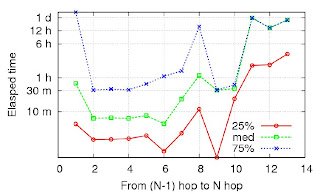Graph of a ReTweet Tree- Pretty Huh ?
I recently came across some informative results in a 2009 study published by the Department of Computer Science, KAIST, in Korea that uncovers some fascinating findings about ReTweets (RT) from analyzing almost 1.5 billion social relations of 42 million twitter profiles in a database of 106 million tweets.
The major findings of the research include:
- RT messages get to 1000 users regardless of number of sender followers.
- RT hops begin in the first minute. 35% of travel is done within 10 minutes, 50% within the hour. 75% in a day.
- RT trains are mostly 1 to 2 hops
The results they found quantitatively tell the story of how effective a RT can be in the real world. More information about ReTweets is available on the Twitter support web site.
Tweet Potential Audience Size
One of the major communication advances of Twitter is the concept of the ReTweet (RT). With a RT, messages are resent from a receiver onto additional receivers in a data network. .Rather than broadcasting the message automatically to all users, each recipient decides whether to forward on the message to their own set of follower recipients. The RT process can easily be done with most of the Twitter clients either by hitting the ReTweet link under the message or by appending the characters 'RT @user " in front of the message. Once an RT is sent the message is sent on to all of the followers of the sender. A common convention that many users do when requesting a message to be RT is to add the string 'Pls RT " to a message.
When a message is sent from a user account, it is sent to all of the account followers.
This is an limited audience message delivery that only goes to the followers of the account. If receiving audience members decide to resend the message to their followers through the RT mechanism then the audience size can grow geometrically:
In this example, instead of only getting only to 3 followers, the RT message has the capability of getting to a total of 12 receiving followers. Theoretically, the additional recievers could RT the message to their followers and the message could travel to all of the millions and millions of Twitter users in an instant !
However, the reality is that RT messages do not cause a Twitterlaynche (Twitter avalanche ) of tens of millions of messages to occur. The reason for this is that users are on at different times and users do not RT every message they receive. Users are temporally spread out so to limit the ability for a message to immediately bounce through the network.
The average time difference between users was shown to be 4 hours. This indicates followers in distant timezones or another distant continent. Users with under 2000 followers, typically had followers within their own time zone.
So what was found to really happen?
Audience Averages 1000
Analysis of the data in the research shows that a RT message typically reaches approximately 1000 users regardless of the number of followers!
My takeaway here is that users with fewer than 1000 followers benefit the most when messages are RT as it increases the exposure of the message. Hashtag useage may have a higher audience view rate than this RT amount. This result dispels the myth that a RT from someone with a large number of followers is more effective than a RT of someone with fewer followers.
RT Characteristics
RT are quickly processed by users in the Twitter network shown in the graph below:
Within 10 minutes, the average message has gotten to 35% of the total audience and by the end of the day it will get to 75% of the audience. Interestingly, a message may continue traveling even after a month of being first sent. You can't hold a good tweet down.
The maximum number of hops, or retransmissions of a message was also found to be severely limited. The majority of messages only take between 1 and 2 RT hops. It appears that network users effectively limit the retransmissions and do not frequently RT messages through the network, thereby, never achieving Twitterlanyche status:
Each RT hop, however, does increase the exposure of a message to a larger audience. As the chart below shows, for the few hops that do occur, the message goes to additional potential viewers.
Further, you can see the effect of RT messages in impressions with services like Tweet Reach. The service shows how many people are seeing a sampling of the last messages. Refer to my prior blog post for more information.
Moreover, messages that RT do so quickly. As shown below, the majority of hops occur within a short period of time after a message is sent.
Twitterlanyche: Plausible or Busted ?
I believe these results show the myth of a RT message causing a avalanche of Twitter traffic is busted. Sure, when a celebrity sends a message or a disaster occurs it can cause a rush of traffic on the network, but in the vast majority of cases, an overload does not appear to occur. It also shows that requesting users to RT your message can have limited benefits as users usually do not RT the message. The vast majority of RT messages simply do not carry enough weight to storm the network. But could this Blog post ?????!!!!!!!
WARNING
DO NOT RETWEET THIS BLOG POST. IT CONTAINS A VIDEO OF THE DEADLIST JOKE IN HISTORY AND COULD BE LETHAL TO ANYONE WHO SEES IT








